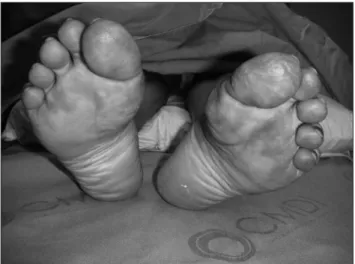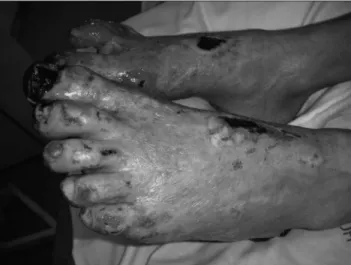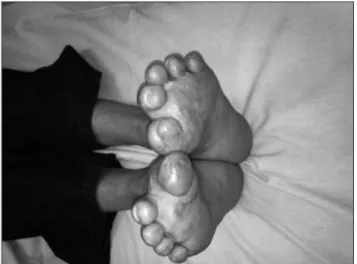Severe ischemia of lower limbs due to arteritis caused by HIV
infection
Isquemia grave de membros inferiores por arterite por HIV
Guilherme Benjamin Brandão Pitta1, Cezar Ronaldo Alves Silva2, Josué Dantas de Medeiros2, Marina Regueira Pitta3, Isabela
Mariz de Lima3, Rafaela Chioquetta3, Mayra Macena Gomes4
Introduction
Acute limb ischemia is deined as any acute reduction of limb perfusion, causing potential threat to limb viability, with less than 14 days of clinical progress1,2. Infection caused
by the human immunodeiciency virus (HIV) may lead to vascular lesions, although this is not common. Such lesions may be a consequence of direct infection of endothelial cells by HIV or result from hypercoagulability3,4.
Several types of vascular lesions have been reported, es-pecially vasculitis5, which comprise a heterogeneous group
of disorders histologically characterized by the presence of inlammatory process iniltrating blood vessel walls6,7. his
scenario hastens the development of cardiovascular diseases8
and may lead to tissue ischemia or afect vessel integrity1,2.
he etiology of vasculopathies associated with HIV in-fection has probably a multifactorial origin. For practical reasons, they were classiied as vasculitis associated with HIV, atherosclerotic vascular disease related to HIV and vasculitis secondary to antiretroviral therapy or both9.
A wide variety of vasculitis can be associated with HIV infection, such as hypersensitivity vasculitis, Abstract
he acute limb ischemia may manifest itself, albeit unusual, as a consequence of vasculitis associated with human immunodeiciency virus (HIV). his case report described a patient seropositive for HIV who developed bilateral distal ischemia with temperature decrease of distal legs and feet, severe pain, cyanosis of ixed toes, and absence of distal pulses. She underwent treatment with thrombolytic therapy, showed signs of injury resulting from ischemia and reperfusion tissue injury with tissue loss in the distal regions of the ingers, but with improvement of the signs and symptoms of lower limbs. It is a rare case in literature due to the association of vasculitis with HIV and to the torment of distal vases of the lower limbs. Despite of that, the knowledge of the pathology is extremely important because of the repercussion in the patients’ lives.
Keywords: thrombosis; vasculitis; thrombolytic therapy.
Resumo
A isquemia aguda de membros pode se manifestar, embora de forma incomum, como consequência à vasculite associada ao vírus da imunodeiciência humana (HIV). O presente caso descreve a evolução de uma paciente soropositiva para o HIV, que apresentou quadro de isquemia distal bilateral, com diminuição da temperatura de terço distal das pernas e pés, dor intensa, cianose ixa de pododátilos e ausência de pulsos distais. Submetida ao tratamento com terapia trombolítica, apresentou sinais de lesões decorrentes da isquemia e lesão tecidual de reperfusão com perda tecidual em regiões distais dos dedos, porém com melhora dos sinais e sintomas dos membros inferiores. Trata-se de um caso raro na literatura em função da associação da vasculite com o HIV e do acometimento dos vasos distais nos membros inferiores. Entretanto, o conhecimento desta associação é de extrema importância devido à repercussão na vida dos pacientes acometidos.
Palavras-chave: trombose; vasculite; terapia trombolítica.
Study carried out at the Hospital Memorial Arthur Ramos – Maceió (AL), Brazil.
Presented at the V Congresso Médico da Universidade Católica de Brasília, in August 2010.
1 Doctor Professor, Universidade de Ciências da Saúde de Alagoas; Angiologist; Vascular Surgeon, Hospital Memorial Arthur Ramos – Maceió (AL), Brazil. 2 Angiologists and Vascular Surgeons, Hospital Memorial Arthur Ramos – Maceió (AL), Brazil.
3 Medical student at Universidade Católica de Brasília – Brasília (DF), Brazil. 4 Medical student at Universidade Federal de Alagoas – Maceió (AL), Brazil.
Financial support: none.
leukocytoclastic vasculitis, periphlebitis retinae, eosino-philic vasculitis, Kawasaki syndrome, polyarteritis nodosa, vasculitis/perivasculitis in the retina and encephalopathy caused by HIV, cutaneous and muscular vasculitis and sys-temic vasculitis6,10. Despite the various types of vasculitis
that have been described, lesions are usually restricted to an isolated or a small number of visceral vessels and they generally afect small- and/or medium-caliber vessels11,12.
It is extremely important to recognize, at the anamnesis and physical examination, the characteristics of acute ar-terial occlusion of the limbs to rule out diferential diag-noses. Acute arterial occlusion is typically characterized by the sudden start of excruciating pain, which may have a rapid or insidious course. he pain may be associated with reduced cutaneous temperature, reduced or no pulses, cy-anosis, paresthesia and paresis13.
he main diferential diagnoses are: ischemic neuropa-thy; diabetic and non-diabetic sensitive neuropaneuropa-thy; relex sympathetic dystrophy and atherosclerosis, when acute stenosis or arterial occlusion is present, although this is usu-ally an uncommon presentation1. hromboembolectomy
is still the treatment of choice to acute arterial occlusion in vessels which caliber allows the surgical access. However, thrombolysis has been proposed as a less invasive alternative, which may replace surgery in speciic cases2, such as when
distal vessels are afected. Prospective, multicenter and ran-domized studies demonstrated that patients with lower limb ischemia, with a maximum of 14-day course, beneitted from thrombolytic therapy in terms of survival, limb salvage, late patency results and complementary surgery magnitude2.
A possible occurrence ater perfusion is restored with thrombolytic therapy of an ischemic limb is ischemia-reperfusion syndrome. It results from functional and
structural alterations that occur ater the blood low is re-stored, causing innumerous harmful efects, such as: necro-sis of injured cells, accentuated cellular edema and uneven low restoration14,15. he tissue injuries can be reversible or
irreversible, proportionally to the ischemia and hypoxia time (period from the onset of occlusion to reperfusion), to which the afected tissue was submitted16.
In this case, the type of vasculitis presented by the patient was characterized by arteritis of distal vessels, which developed into acute thrombosis of the distal arteries of lower limbs and, consequently, distal ischemia of both lower limbs.
Objective
his article consists of the case report of an acute dis-tally located lower limbs arterial thrombosis in a female patient, HIV-seropositive, who presented with severe limb ischemia due to HIV-associated vasculitis.
Methods
A 38-year-old married female and HIV-seropositive patient, born in Maceió, in the State of Alagoas, was on antiretroviral therapy with zidovudine, lamivudine and efavirenz for about two years, with no evidence of disease activity. he patient presented bilateral distal ischemia with reduced temperature of distal third of both legs and feet, intense pain, ixed cyanosis of toes and absence of distal pulses (Figures 1 e 2).
he patient underwent lower limb angiography via an-tegrade femoral catheterization, using Seldinger’s technique. he exam showed bilateral occlusion of the anterior and posterior tibial arteries and ibular artery, from the middle
Figure 3. Angiography for pre-thrombolytic control showing absence of blood low in the distal third of left leg and foot.
Figure 4. Angiography for pre-thrombolytic control showing absence of blood low in the distal third of right leg and foot.
Figure 5. Angiography for pre-thrombolytic control showing absence of blood low in the distal third of right leg and foot.
Figure 6. Angiography for pre-thrombolytic control showing revascu-larization of the distal third of left leg and foot.
third of the legs to the feet (Figures 3 to 5). hrombolytic therapy with 50 mg alteplase was carried out for three days. On the irst day, 10 mg of alteplase was diluted in 100 mL of glucose solution and administered as an intra-arterial bolus. he remaining 40 mg were diluted in 200 mL of glu-cose solution and were administered throughout the next 24 hours. he following two days 50 mg of alteplase, diluted in 200 mL of glucose solution, were administered daily. he ibrinolytic therapy was monitored through plasma ibrino-gen level monitoring every eight hours.
In addition, intravenous therapy was initiated with 50 mg hydrocortisone every 12 hours, for ten days, to treat the vasculitis.
Bilateral lower limb angiography for post-thrombolytic therapy control showed improved perfusion and revascu-larization of the distal third of both lower limbs and feet
(Figures 6 to 8). She developed necrosis and phlyctenas of both halluces (Figure 9). However, the patient presented improve-ment of the pain, cyanosis and low temperature of the limbs and delimitation of the areas of necrosis. hen, she was given 20 µcg of alprostadil (PGE1), diluted in 100 mL of saline solu-tion, every 12 hours, using an infusion pump, and 60 mg of subcutaneous enoxaparin sodium every 12 hours. Both were started on day 3 of treatment, ater thrombolytic therapy had been discontinued and kept until discharge from hospital.
At the end of treatment, salvage of afected limbs oc-curred, with the ischemic condition resolved and reperfu-sion of both lower limbs. A limited debridement of the digi-tal pulps of halluces was necessary (Figures 10 and 11).
Results
frequency and expression of several related clinical syn-dromes. Furthermore, antiretroviral therapy is directly as-sociated with drug toxicity and indirectly asas-sociated with the immune system reconstruction, and the development of new syndromes, as the HIV infection causes imbalance in the immune system, characterized by immunosuppression and hyperactivity. Such alterations of the immune system may lead to reduced self-tolerance and eventually to the development of autoimmunity17. Antiretroviral therapy can
be regarded as one of the causes of vasculitis in small- and medium-caliber vessels. he drugs suggested as possible in-ducers include abacavir, nevirapine, efavirenz, trimethopim/ sulfamethoxazole, among others9. It is not possible to
deter-mine whether there was any inluence of the drugs being used in the reported case, but a possible interaction of this factor in the development of acute arterial occlusion in the patient can not be ruled out.
he intra-arterial thrombolysis used in the patient’s treatment is the therapy of choice when small-caliber distal
Figure 9. Necrosis of hallux and phlyctenas occurring bilaterally as a result of post-thrombolysis ischemia and reperfusion injury.
Figure 8. Angiography for pre-thrombolytic control showing revascu-larization of the distal third of right leg and foot.
Figure 7. Angiography for pre-thrombolytic control showing revascu-larization of the distal third of right leg and foot.
Figure 10. Salvage of lower limbs and debridement of distal extremities of halluces.
Figure 11. Salvage of lower limbs, after three months of treatment.
Discussion
he symptoms presented by the patient can be ex-plained by reduced arterial blood low in the distal third of lower limbs, due to acute arterial occlusion caused by thrombus, secondary to HIV- associated arteritis.
vessels are afected, as it allows the drug to reach the injury site in a more efective and faster manner than thromboem-bolectomy, and it can ensure unclogging of the main arter-ies, as well as smaller distal vessels2. he treatment eicacy
could be demonstrated by proper blood perfusion of the afected limbs.
he treatment of vasculitis is essentially based on the combined administration of corticosteroids with cytotoxic drugs (cyclophosphamide is the most frequently used)18.
Corticotherapy with hydrocortisone was necessary in the treatment of this type of vasculitis to control or to induce remission of the disease and to prevent relapses, minimiz-ing sequelae19. he drug selection was an indication of the
Infectology team. Cyclophosphamide was not used, because the patient was already taking immunosuppressors for the HIV treatment.
Alprostadil is a compound made from naturally oc-curring fatty acids, with several pharmacological effects, such as vasodilation and platelet aggregation inhibi-tion20. The use of this drug was essential for the patient’s
progress, as it antagonizes the formation of new thrombi and, consequently, prevents possible arterial occlusion in other areas. Necrosis of the digital pulps of halluces and the occurrence of phlyctenas resulted from the isch-emia-reperfusion syndrome, which appeared after limb revascularization14-16.
In principle, the presence of thrombophilia mark-ers influence the decision to prevent new thrombotic events (secondary prophylaxis) and may help to decide on duration and intensity of therapy 21. However, the
in-vestigation of thrombophilia markers was not required for this patient, since it is not a routine practice for pa-tients taking anticoagulants, and the detection of such markers does not influence the treatment of an acute event, because the treatment of thrombosis is not de-pendent on its cause.
Conclusion
HIV infection presents various interaction with the afected patient’s health. his case report demonstrates the importance of having broad and proper perception re-garding the possible associated conditions that may occur as a result of this disease. Vasculitis associated with HIV are rare, but cause an important repercussion on the pa-tient’s life, due to their possible complications and future impairments. Based on that, it concludes that an aggres-sive and adequate treatment is essential for the remission of situations that arise in this context and to ensure the patient’s quality of life.
References
1. Baptista-Silva JCC. Isquemia Crônica Crítica de Membro: Diagnóstico Clínico. In: Pitta GBB, Castro AA, Burihan E, editores. Angiologia e cirurgia vascular: guia ilustrado. Maceió: UNCISAL/ ECMAL & LAVA; 2003.
2. Rossi FH, Izukawa NM, Oliveira LAV, Silva DG. O valor atual da trombólise na oclusão arterial aguda do membro inferior. J Vasc Br. 2003;2(2):129-40.
3. Cotter BR, Andrade ACO. Endothelial Function and Cardiovascular Diseases in HIV Infected Patient. BJID. 2006;10(2):139-45.
4. Bush RL, Bianco CC, Bixler TJ, Lin PH, Lumsden AB. Spontaneous arterial thrombosis in a patient with HIV infection – successful treatment with pharmacomechanical thrombectomy. J Vasc Surg. 2003;38(2):392-5.
5. Loire R, Capron L. Complications vasculaires del ínfection par Le VIH. Sang hrombose Vaiseaux. 1995;7(7):487-92.
6. Bozza A, Levy R. Vasculites. In: Pitta GBB, Castro AA, Burihan E, editores. Angiologia e cirurgia vascular: guia ilustrado. Maceió: UNCISAL/ECMAL & LAVA; 2003.
7. Ramaprasad C, Pitrak D. Infections of the peripheral arterial system. In: Dieter RS, Dieter RAJr, Dieter RAIII. Peripheral arterial disease. Nova York: McGraw Hill Professional; 2008. p. 157-68.
8. Chi D, Henry J, Kelley J, horpe R, Smith JK, Krishnaswamy G. he efects of HIV infections on endothelium function. Endothelium. 2000;7(4):223-42.
9. Naidoo NG, Beninield SJ. Other manifestations of HIV vasculopa-thy. Sajs. 2009;47(2):46-53.
10. Cossermelli W. Vasculites. In: Vasculites associadas às infecções. São Paulo: Fundação para o desenvolvimento da Reumatologia; 2002. p. 135-48.
11. Chetty R. Vasculitides associated with HIV infection. J Clin Pathol. 2001;54(4):275-8.
12. Staub HL. Vasculites imunológicas – diagnóstico e diagnóstico diferencial. Tem Reumatol Clin. 2008;9(3):72-6.
13. Pereira DAG, Custódio MX, Carvalho JPF, Carvalho AMB, Cunha-Filho IT. Avaliação e tratamento isioterápico na doença arterial obstrutiva periférica de membro superior: um estudo de caso. J Vasc Br. 2008;7(1):72-5.
14. Bitu-Moreno J, Francischetti I, Hafner L. Lesões de isquemia-reper-fusão em músculos esqueléticos: isiopatologia e novas tendências de tratamento, com ênfase em reperfusão controlada. J Vasc Br. 2002;1(2):113-20.
15. Brasileiro JL, Fagundes DJ, Miiji LON, Oshima CTF, Teruya R, Marks G, et al. MA. Isquemia e reperfusão de músculo sóleo de ratos sob ação da pentoxiilina. J Vasc Br. 2007;6(1):50-63.
16. Campos EBP, Yoshida WB. O papel dos radicais livres na isio-patologia da isquemia e reperfusão em retalhos cutâneos: modelos experimentais e estratégias de tratamento. J Vasc Br. 2004;3(4):357-66.
17. Macedo CG, Panato CS, Borjaille BP, Antônio SF. Manifestações reumatológicas e auto-imunes em pacientes. Rev Bras Med. 2006;7(2):71-7.
19. Guillevin L, Dörner T. Vasculitis: mechanisms involved and clinical manifestations. Arthritis Res her. 2007;9(Suppl 2):S9.
20. Araújo M. Farmacoterapia nas doenças vasculares periféricas. In: Pitta GBB, Castro AA, Burihan E, editores. Angiologia e cirurgia vascular: guia ilustrado. Maceió: UNCISAL/ECMAL & LAVA; 2003. pt.13, cap.74. Disponível em: http://www.lava.med.br/livro/pdf/ marcelo_farmacoterapia.pdf.
21. Tripodi A, Mannacci PM. Laboratory investigation of thrombo-philia. Clin Chem. 2001;47(9):1597-606.
Correspondence
Marina Regueira Pitta CCSW 02, Lote 1 – Bloco 2 – Apto. 210 CEP 70680-250 – Brasília (DF), Brazil E-mail: marina_pitta@hotmail.com
Author’s contributions


